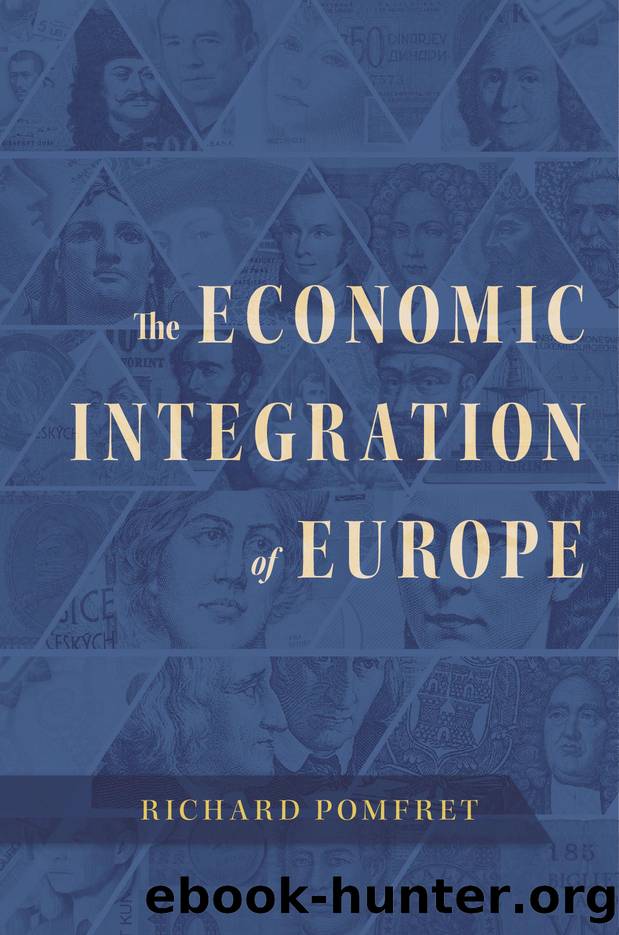The Economic Integration of Europe by Richard Pomfret

Author:Richard Pomfret [Pomfret, Richard]
Language: eng
Format: epub
Tags: Business & Economics, General, Economic History, history, Europe, Great Britain, 21st Century, political science, Public Policy, Social Policy, World, European
ISBN: 9780674244139
Google: i14lEAAAQBAJ
Publisher: Harvard University Press
Published: 2021-06-08T00:17:23.146523+00:00
5.3â â â Brexit
When the UK joined the European Communities in 1973, the acquis communautaire that it accepted did not extend far beyond the customs union and CAP.
From the late 1970s to the early 1990s, the UK stood apart from the majority as it negotiated opt-outs on monetary integration and on Schengen, as well as obtaining a special budget arrangement. Following the Maastricht Treaty (1993), which committed signatories to deeper integration and monetary union on the path to closer union, a strong Eurosceptic movement emerged in the UK, including the UK Independence Party (UKIP).34 In the 2014 elections for the European Parliament, UKIP won more votes than any other party in the UK. The British government held a referendum in June 2016 on UK membership in the EU, offering the simple choiceâleave or remain? By a 52â48 majority, voters chose leave. Prime Minister David Cameron, who had supported remain, resigned the following day.
Support for leave in the referendum came primarily from older, more rural, less educated, and less economically successful voters, who felt left behind by economic integration and globalization (Sampson 2017, 175â178). Evidence is unclear on whether they specifically voted to shift control from the EU to the UK or were scapegoating the EU for wider concerns associated with globalization. Nevertheless, the historical record suggests British reservations about federalism and a more transactions-based view of European integration going back at least to the 1980s negotiations about âfairâ budget contributions to balance what the UK paid in and what it got out of membership. In 2016, the UK debate focused on economic costs and benefits of EU membership, with some attention to migration but virtually no focus on bonds of Europeanness.
There was no relevant precedent for withdrawal from the EU. Previous exits were special cases inapplicable to Brexit. In 1962, when Algeria gained independence from France, it also ceased to be part of the European Communities. In 1985, Greenland, following Denmarkâs granting of home rule, exited the EU. In 2012, Saint Barthélemy, following secession from the French overseas region of Guadeloupe, withdrew from the EU and became an Overseas Country and Territory (OCT).35
The new prime minister, Theresa May, set out her strategy for negotiating Britainâs EU exit (Brexit) in a February 2017 white paper.36 The paper stated that the UK would not seek to remain in the EUâs Single Market and would pursue a new strategic partnership with the EU, including a customs arrangement that would allow the UK to sign new trade agreements with other countries. In March 2017, the UK triggered exit negotiations by invoking Article 50 of the Lisbon treaty which provided for a two-year deadline before Brexit in March 2019. May then made the disastrous decision to call a general election in May 2017 in hopes of strengthening her position. In the election, the Conservative Party lost its majority in Parliament and would henceforth govern with the support of the Democratic Unionist Party which was committed to maintaining the status of Northern Ireland within the UK.
After the referendum, the EU27 moved quickly to coordinate their response.
Download
This site does not store any files on its server. We only index and link to content provided by other sites. Please contact the content providers to delete copyright contents if any and email us, we'll remove relevant links or contents immediately.
Zero to IPO: Over $1 Trillion of Actionable Advice from the World's Most Successful Entrepreneurs by Frederic Kerrest(4073)
Machine Learning at Scale with H2O by Gregory Keys | David Whiting(3654)
Harry Potter and the Goblet Of Fire by J.K. Rowling(3615)
Never by Ken Follett(3545)
Ogilvy on Advertising by David Ogilvy(3349)
Shadow of Night by Deborah Harkness(3181)
The Man Who Died Twice by Richard Osman(2818)
Book of Life by Deborah Harkness(2726)
My Brilliant Friend by Elena Ferrante(2707)
How Proust Can Change Your Life by Alain De Botton(2620)
0041152001443424520 .pdf by Unknown(2608)
Will by Will Smith(2589)
The Tipping Point by Malcolm Gladwell(2565)
How to Pay Zero Taxes, 2018 by Jeff A. Schnepper(2505)
Purple Hibiscus by Chimamanda Ngozi Adichie(2501)
Hooked: A Dark, Contemporary Romance (Never After Series) by Emily McIntire(2428)
Rationality by Steven Pinker(2156)
Borders by unknow(2121)
Daughter of Smoke and Bone by Laini Taylor(2086)
